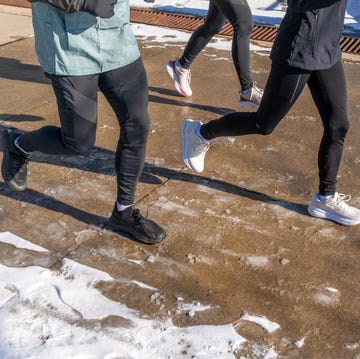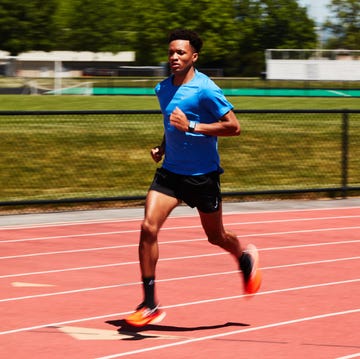As a coach, I try to help runners like you reach their full potential. Not every runner has the potential to win races or break records, but mastering the sport of running is not about being faster than everyone else. It’s about finding the absolute limit of your ability.
This takes time, of course. There’s a developmental process each of us must go through to reach our full potential, a process that has both physical and mental components.
On the mental side, mastery is all about control. We don’t control everything as runners, but we do control our decisions, and if we make good decisions in pursuing our limit, we will eventually reach it. On the road to mastery, we progress by learning to make better decisions more often—it’s as simple as that.
In my latest book, Chasing Mastery: 25 Lessons to Cultivate Your Full Potential in Endurance Sports, I divide the developmental process into five stages, each defined by what the athlete needs most to continue on their journey toward mastery.
Beginners need motivation above all—with motivation comes the oomph required to stretch toward personal greatness. Once a runner has the motivation to begin the journey, learning becomes primary, supplying the tools required to make use of our motivation in a smart way. Then comes understanding, which enables athletes to always choose the right tool for the occasion; individuation, in which runners discover ways to refine and personalize their toolset; and finally, the challenge stage, in which the need to avoid complacency becomes paramount.
Let’s have a closer look at these five stages.
Stage 1: Motivation
Motivation is important in all sports, but in running it’s especially critical. That’s because running performance is limited by perceptions rather than physiology. If a person is asked to run on a treadmill until they can’t, they’ll quit not when their body gives out but when the effort becomes intolerable. The more motivated the runner, the more effort they’re willing to tolerate and the better they perform.
The main source of motivation for runners is enjoyment of the sport. You have to train hard to improve, of course, but the more fun you’re having, the more you’ll get out of your hard work.
I use the “Hard Fun Test” to help my athletes maximize their motivation. Ask yourself, “Is my current training at least as fun as it is hard?” If it’s not, brainstorm ways to inject more fun into the process, whether it’s by mixing up your workouts, running with others more often, finding a more exciting goal to chase, or something else.
Stage 2: Learning
Running is a simple sport, but there’s a lot to learn. No runner starts off knowing how to balance different intensities in training, how to sequence work and rest within the week and across weeks, how to pace themselves in workouts and races, and so on. In my experience, the most avid learners make the quickest progress toward mastery.
Not all sources of learning are equally credible, however, so be selective. The most credible teachers are those who base their guidance on three factors:
- Real-world best practices—methods widely practiced at the elite level
- Relevant science—not one random study but a larger body of evidence supporting a particular practice
- Empathetic pragmatism—an understanding of how to apply scientifically supported best practices to runners like you
Consider these three criteria when deciding whether to put your trust in a coach, author, or other source of running-related learning. By all means, prioritize learning, but be a filter, not a sponge, in the learning stage of your journey toward mastery.
Stage 3: Understanding
To reach your full potential as a runner, it’s not enough to learn the rules of training. You must also be able to function as a creative problem-solver. Like it or not, you will routinely encounter challenges in your training and development that don’t have an immediate and obvious solution. No runner makes the right call every time in these situations, but you’ll find the best solution more often if you lean on your understanding of the deep principles that underlie the rules and treat the search for the best solution as a kind of experiment.
The basic steps of creative problem-solving are:
- Define the problem
- Develop hunches about how to solve it
- Test your best hunch
- Evaluate the results
- Test another hunch if the problem remains unfixed
For example, suppose your fitness level plateaus unexpectedly in the middle of a training build. Your best hunch is that your calorie intake has failed to keep up with your training load, so you try eating more and, voila, you’re back on track.
The important thing to keep in mind in the problem-solving process is that you don’t have to know the answer; if you follow these steps, you will find it sooner or later.
Stage 4: Individuation
No two runners are the same. While the general rules of training and development apply to everyone, each runner has a unique formula for reaching their full potential that is different in its details. The individuation stage of the journey toward mastery is all about tweaking universal best practices to make the process work better for you.
Some runners thrive on high mileage, while others require a more conservative approach. Some runners have natural endurance but really need to work on their speed, while others are the opposite, and so on.
Use your training log to identify patterns of cause and effect in your training. Pay particular attention to how specific inputs—such as workout types—affect your fatigue level, fitness markers, injury risk, confidence, and enjoyment of training. When you feel you need more of something, try doing more, and if you feel you need less, or something different, try that.
By taking this approach, you will gradually evolve a personal optimal training formula that adheres to general rules but applies them in a way that suits your needs and preferences.
Stage 5: Challenge
Runners who reach the challenge stage of their development have earned a high degree of control over their running and are making mostly good decisions. The number-one factor that stops progress at this point in the journey is complacency, or the mistake of assuming you have it all figured out.
To avoid this trap, make a consistent effort to challenge yourself in ways that keep you moving forward. One way to make this effort systematic is to pick one to three new things to try in each training cycle. Some examples include switching from pace-based training to power-based training, hiring a coach or changing coaches, and incorporating cross-training into your program.
There is no endpoint to the journey toward mastery. Runners who reach this level always believe they can get even better at their sport, and they do so by continuing to challenge themselves in new ways. In 25 years of coaching, I’ve seen a lot of runners make remarkable progress toward mastering the sport, and I know you can, too!













